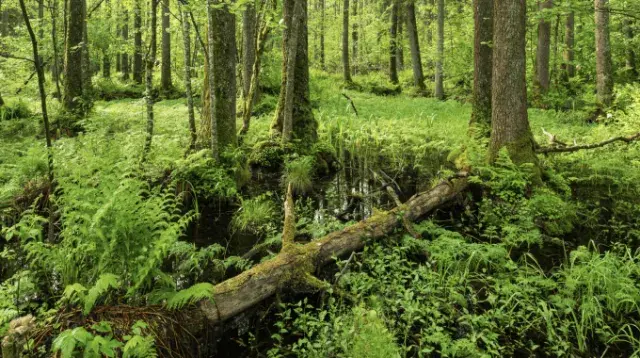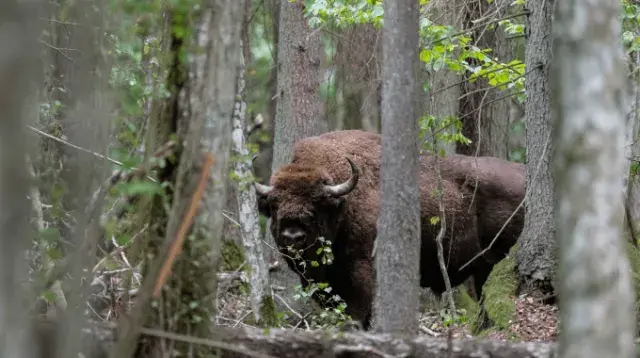The return of a primary forest in Europe
Although they covered a large part of the continent for millions of years, primary forests have almost completely disappeared from Europe since 1850. If the development of the human species has been fatal to them, make no mistake about it: we are the great losers in their disappearance. Restoring them is vital for the future of the planet and the protection of biodiversity. The Francis Hallé Association, with the support of the Klorane Botanical Foundation, has taken up this challenge, both in scope and duration.
The urgency of doing nothing
A primary forest is one that hasn’t been cleared, exploited or modified in any way by human intervention. They are nature at its purest, models of self-regulation and incomparable biodiversity hotspots. CO2 capture, climate regulation, biodiversity reserves, water resource replenishment... the benefits really are incalculable. And these forests were the norm until human beings arrived around 300,000 years ago.

Primary forests don’t care about human calendars or clocks. In temperate zones, they can take up to 1,000 years to develop from bare soil. Things move a little quicker in the tropics, where forests “only” take 700 years to mature. Primary forests can be recreated from so-called secondary forests – ones that have undergone human intervention – over a period of around 800 years, provided they’re left alone.
© Jessica Buczek
The United Nations Environment Programme (UNEP) estimates that 80% of primary forests have been felled over the last century. The last known survivors can be found in the tropics in the Amazon, the Congo Basin and South-East Asia, as well as in temperate zones in Patagonia, Tasmania and British Columbia (Canada). Europe’s primary forests have all but disappeared, with only one real jewel in the crown remaining, the Białowieża forest, which straddles the Poland-Belarus border.
The Francis Hallé Association has come up with a wild yet simple idea: restoring a primary forest in Europe, turning 70,000 hectares of space over to nature, free from all human intervention. In other words, a commitment to do absolutely nothing for at least 800 years.
The art of leaving well alone
So how might this resurrection work? Once an area of secondary forest has been demarcated and protected, we’ll first see the natural deaths of the pioneer trees (pines and birches), whose dead wood will enrich the soil and encourage diversity among fungi and insects. Then, without any planting, post-pioneer trees will appear, including ashes, lindens and maples, which will build up the forest before ageing and disappearing when their time naturally comes. This will be the right time to introduce those larger animals that haven’t quite managed to move in on their own, including bears and European bison, who will make the most of clearings and blown over trees. Finally, space will be taken over by oak and beech trees, and the primary forest will continue to grow in height and become ever richer in terms of plants and animals.

During this long period of time when the forest is left to evolve freely and naturally, all plant removals and poaching will be strictly prohibited, but this paradise under (re)construction will have to remain open to regulated visits, in order to serve as an educational tool and research subject. The potential in terms of scientific knowledge is incalculable.
© Pierre Chatagnon
70,000 hectares – or roughly the size of an average European city – is all that’s required for this vital experiment led by the Francis Hallé Association. This critical figure has been reached because of its capacity to host a coherent ecosystem and shelter large animals in flourishing buffer zones. Several regions in Western Europe are under consideration, selected on the basis of scientific criteria (forest base, altitude) and their cross-border locations, which would help guarantee an adequate level of governance over hundreds of generations. Financial support from Klorane Botanical Foundation will facilitate the preliminary phases of the project, including looking into potential sites, approaching institutions, raising awareness among public stakeholders, as well as setting out guidelines in biodiversity development.
It’s a commitment over an unprecedented period of time – a period that’s more natural than human – to a multidisciplinary pilot project that will involve a large number of scientific, political and civil society stakeholders. A project that’s almost civilisational in scope, in an attempt to respond to the absolute urgency of climate change and the collapse of biodiversity, reinventing our societies’ relationships with forests and natural spaces.
Our Partner
Founded in 2019, the Francis Hallé Association works to promote the resurrection of a primary forest in Western Europe. The association is working to create a vast space of around 70,000 hectares where an untouched forest can be left to evolve on its own, renewing and developing its flora and fauna without any human intervention whatsoever over a period of several centuries.

Who is Francis Hallé ?
An internationally renowned botanist, biologist and dendrologist, Francis Hallé has devoted his career to the ecology of tropical forests and the architecture of their trees. From his thesis in 1966 to the creation of the Association for a primary forest in Western Europe in 2019, he has worked tirelessly to advance scientific knowledge, preserve natural environments and raise awareness of these precious treasures.
© Pierre Chatagnon
